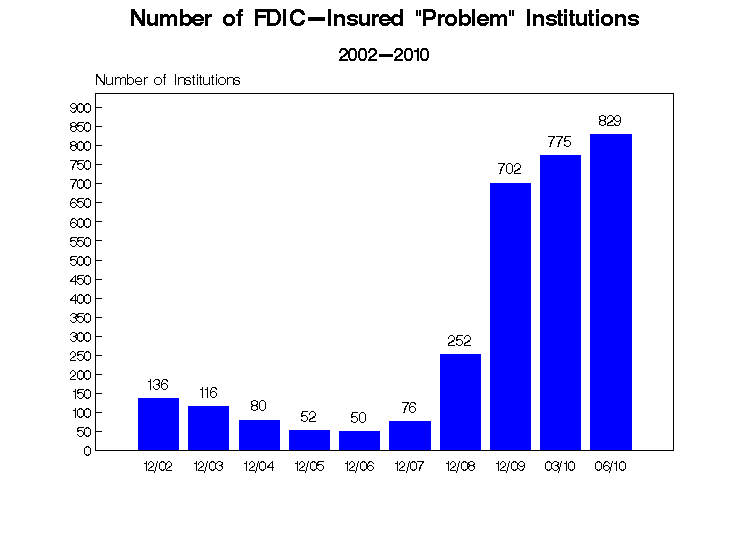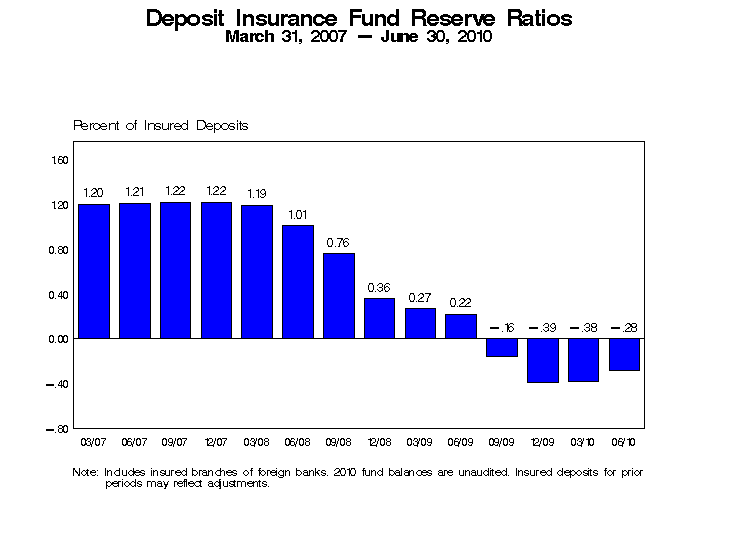October 22, 2010 – Regulators closed seven banks today in five different States. The total number of banking failures is now only one shy of last year’s total of 139. Banking failures are now at the highest level since 1992 when a large number of banks failed due to the savings and loan crisis.
Highlights of this week’s banking failures include:
- Depositors of failed First Arizona Bank are shocked to lose $5.8 million as the FDIC fails to find a buyer for the failed bank.
- The week’s largest banking failure occurred in Kansas when $1.6 billion Hillcrest Bank failed. The Bank’s website had advertised Hillcrest as “safe and secure, built on solid growth and conservative by nature.”
- Three failed banks were purchased from the FDIC by banks who still have outstanding loans from the US Treasury under the TARP bailout program. See First Bank of Jacksonville, Progress Bank of Florida and First National Bank of Barnesville.
- The seven failed banks this week had total assets of $2.4 billion and total deposits of $2.2 billion. The total estimated loss on the seven failed banks to the depleted FDIC Deposit Insurance Fund is estimated at $478 million.
Problems Are Not Going Away for Problem Banks
Although the largest banks have been able to raise capital and are reporting earnings, smaller banks are finding it extremely difficult to raise additional capital and cope with continued loan losses that have crippled bank earnings capacity.
Given the increasing number of banks on the FDIC’s Problem Bank List, it is surprising that this year’s tally of banking failures has not been much higher.
As of the latest report released by the FDIC there were 829 problem banks at June 30, 2010 up from 775 at March 31. Total assets held by the troubled institutions is $403.0 billion, a slight decrease from $431 billion in the previous quarter.
The historic low for the Problem Bank List was reached in the third quarter of 2006 with 47 banks. The FDIC’s Problem Bank List of 829 banks is the largest number since March 31, 1993 when there were 928. Problem Banks now account for over 10% of all banking institutions. As of August 2010, there were 7,932 FDIC insured banking institutions with total assets of $13.2 trillion.
In general, banks included on the list have serious deficiencies with their finances, operations, or management that threaten their continued solvency. Once a bank is included on the list, they are subject to closer regulatory scrutiny. They can also expect to receive instructions from regulators about what steps must be taken to rebuild their financial strength.

Making the problem even worse, the FDIC Deposit Insurance Fund has been completely depleted and now has a negative fund balance of $15.2 billion at June 30, 2010.
The DIF fund had been strengthened by a special FDIC assessment of $46 billion on the banking industry at the end of 2009. The FDIC presently has liquid resources of $44 billion, a decline from $63 billion at the end of the first quarter. Liquid resources of the FDIC Insurance Fund, however, represent only a tiny fraction of total FDIC insured deposits of $5.5 trillion.
 This week’s seven banking failures occurred in five different States as listed below. Please click on the link for detailed information on each bank closing.
This week’s seven banking failures occurred in five different States as listed below. Please click on the link for detailed information on each bank closing.
First Arizona Savings, A FSB, Scottsdale, AZ – Banking Failure #139
Hillcrest Bank, Overland Park, KS – Banking Failure #138
First Suburban National Bank, Maywood, Illinois – Banking Failure 137
The First National Bank of Barnesville, Barnesville, GA – Banking Failure #136
The Gordon Bank, Gordon, GA – Banking Failure #135
Progress Bank of Florida, Tampa, FL – Banking Failure #134
First Bank of Jacksonville, Jacksonville, FL – Banking Failure #133
Speak Your Mind
You must be logged in to post a comment.